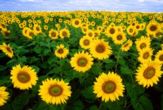Mystery Solved: How Plants Know When to Flower

Scientists have known since the 1930s that plants sense the length of the days and, somehow, use that information to decide when to flower.
Russian scientists back then speculated that a mysterious substance must be transported from leaves to shoot tips, stimulating the formation of flower buds. They called the mystery chemical "florigen."
A trio of new studies announced today seem to reveal how it works, including why flowers spring forth in certain spots on a plant.
"We have now shown that a gene called FT, which is active in the leaf and whose activity is regulated by the day length, produces a messenger molecule that is transported to the shoot tip," said Ove Nilsson at the Umea Plant Science Center at the Swedish University of Agricultural Sciences.
Separate research, conducted by a different team, reveals how the messenger molecule works to activate the "gene programs" that lead to the formation of floral buds.
In short, proteins are formed and they talk to other proteins that exist only at the future locations of buds, and flowers are born at just the right time in a preprogrammed location.
Temperature and soil conditions play a role in the timing, too, the scientists said.
Get the world’s most fascinating discoveries delivered straight to your inbox.
"Together these data show that the messenger molecule produced by FT either is the elusive florigen, or is a very important component of florigen," Nilsson told LiveScience.
And why does this matter to scientists?
Daffodils bloom in spring as the days get longer. Roses wait until summer. Rice, on the other hand, flowers in the fall as the days shorten. Nature does fine, of course, but humans sometimes want to fool her.
"It is interesting to speculate that this finding could be used to make early flowering rice," Nilsson said. "Since many of the high yielding varieties are late flowering this could in certain parts of the world allow the production of more than one harvest per year."
The findings are reported by the journal Science.
It has not been clear how plants combine all the information needed to build a flower, writes Spanish researcher Miguel Blazquez in an analysis in the journal. The new studies "reveal the molecular mechanism by which this integration is achieved," he said.
- More on Plant Smarts
- Flower Power: See Amazing Images
- Human Affection Altered Evolution of Flowers
- World's Largest Flower Skips Sex
Robert is an independent health and science journalist and writer based in Phoenix, Arizona. He is a former editor-in-chief of Live Science with over 20 years of experience as a reporter and editor. He has worked on websites such as Space.com and Tom's Guide, and is a contributor on Medium, covering how we age and how to optimize the mind and body through time. He has a journalism degree from Humboldt State University in California.



